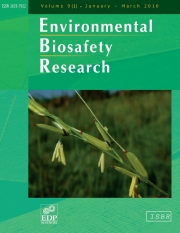Crossref Citations
This article has been cited by the following publications. This list is generated based on data provided by
Crossref.
Sanvido, Olivier
Romeis, Jörg
Gathmann, Achim
Gielkens, Marco
Raybould, Alan
and
Bigler, Franz
2012.
Evaluating environmental risks of genetically modified crops: ecological harm criteria for regulatory decision-making.
Environmental Science & Policy,
Vol. 15,
Issue. 1,
p.
82.
Raybould, Alan
Kurtz, Ryan
and
Zeph, Lawrence
2012.
Regulation of Agricultural Biotechnology: The United States and Canada.
p.
317.
Raybould, Alan
and
Poppy, Guy M.
2012.
Commercializing genetically modified crops under EU regulations.
GM Crops & Food,
Vol. 3,
Issue. 1,
p.
9.
Raybould, Alan
Higgins, Laura S.
Horak, Michael J.
Layton, Raymond J.
Storer, Nicholas P.
De La Fuente, Juan Manuel
and
Herman, Rod A.
2012.
Assessing the ecological risks from the persistence and spread of feral populations of insect-resistant transgenic maize.
Transgenic Research,
Vol. 21,
Issue. 3,
p.
655.
Yoshimura, Yasuyuki
and
Matsuo, Kazuhito
2012.
The Current State of the Environmental Impact Assessment of Abiotic Stress-Tolerant Genetically Modified Plants in the U.S., Canada, Australia, EU and Japan.
Japanese Journal of Crop Science,
Vol. 81,
Issue. 2,
p.
137.
Jansen van Rijssen, Fredrika W.
Morris, E. Jane
and
Eloff, Jacobus N.
2013.
Food Safety: Importance of Composition for Assessing Genetically Modified Cassava (Manihot esculenta Crantz).
Journal of Agricultural and Food Chemistry,
Vol. 61,
Issue. 35,
p.
8333.
Tepfer, Mark
Racovita, Monica
and
Craig, Wendy
2013.
Putting problem formulation at the forefront of GMO risk analysis.
GM Crops & Food,
Vol. 4,
Issue. 1,
p.
10.
Romeis, Jörg
Raybould, Alan
Bigler, Franz
Candolfi, Marco P.
Hellmich, Richard L.
Huesing, Joseph E.
and
Shelton, Anthony M.
2013.
Deriving criteria to select arthropod species for laboratory tests to assess the ecological risks from cultivating arthropod-resistant genetically engineered crops.
Chemosphere,
Vol. 90,
Issue. 3,
p.
901.
Devos, Yann
Sanvido, Olivier
Tait, Joyce
and
Raybould, Alan
2014.
Towards a more open debate about values in decision-making on agricultural biotechnology.
Transgenic Research,
Vol. 23,
Issue. 6,
p.
933.
Yakovleva, Irina Vladimirovna
Vinogradova, Svetlana Vladimirovna
and
Kamionskaya, Anastasiya Mikhaylovna
2015.
State regulation of the biotechnology (GM) agricultural products: analysis of different approaches in the world.
Ecological genetics,
Vol. 13,
Issue. 2,
p.
21.
Ladics, Gregory S.
Bartholomaeus, Andrew
Bregitzer, Phil
Doerrer, Nancy G.
Gray, Alan
Holzhauser, Thomas
Jordan, Mark
Keese, Paul
Kok, Esther
Macdonald, Phil
Parrott, Wayne
Privalle, Laura
Raybould, Alan
Rhee, Seung Yon
Rice, Elena
Romeis, Jörg
Vaughn, Justin
Wal, Jean-Michel
and
Glenn, Kevin
2015.
Genetic basis and detection of unintended effects in genetically modified crop plants.
Transgenic Research,
Vol. 24,
Issue. 4,
p.
587.
Nakai, Shuichi
Hoshikawa, Kana
Shimono, Ayako
and
Ohsawa, Ryo
2015.
Transportability of confined field trial data from cultivation to import countries for environmental risk assessment of genetically modified crops.
Transgenic Research,
Vol. 24,
Issue. 6,
p.
929.
2016.
Guidance to develop specific protection goals options for environmental risk assessment at EFSA, in relation to biodiversity and ecosystem services.
EFSA Journal,
Vol. 14,
Issue. 6,
2016.
Coverage of endangered species in environmental risk assessments at EFSA.
EFSA Journal,
Vol. 14,
Issue. 2,
Hewett, Joel P.
Wolfe, Amy K.
Bergmann, Rachael A.
Stelling, Savannah C.
and
Davis, Kimberly L.
2016.
Human Health and Environmental Risks Posed by Synthetic Biology R&D for Energy Applications.
Applied Biosafety,
Vol. 21,
Issue. 4,
p.
177.
Pascher, Kathrin
2016.
Spread of volunteer and feral maize plants in Central Europe: recent data from Austria.
Environmental Sciences Europe,
Vol. 28,
Issue. 1,
Devos, Y.
Álvarez‐Alfageme, F.
Gennaro, A.
and
Mestdagh, S.
2016.
Assessment of unanticipated unintended effects of genetically modified plants on non‐target organisms: a controversy worthy of pursuit?.
Journal of Applied Entomology,
Vol. 140,
Issue. 1-2,
p.
1.
2016.
Recovery in environmental risk assessments at EFSA.
EFSA Journal,
Vol. 14,
Issue. 2,
Yakovleva, I. V.
Vinogradova, S. V.
and
Kamionskaya, A. M.
2016.
Governmental regulation of genetically modified agricultural products: Analysis of different approaches in the world.
Russian Journal of Genetics: Applied Research,
Vol. 6,
Issue. 6,
p.
646.
Devos, Yann
Ortiz-García, Sol
Hokanson, Karen E.
and
Raybould, Alan
2018.
Teosinte and maize × teosinte hybrid plants in Europe−Environmental risk assessment and management implications for genetically modified maize.
Agriculture, Ecosystems & Environment,
Vol. 259,
Issue. ,
p.
19.

